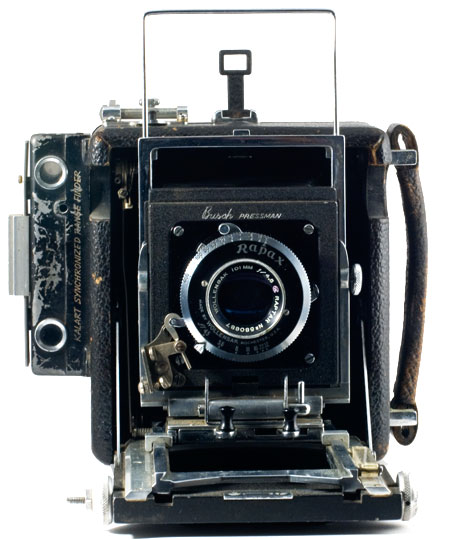
Approx. dates of manufacture: unknown
Approx. original price: $73.40
Approx. street value: moderate
I don't know much about Busch, sadly. In fact I know almost nothing except that they were a Chicago-based company that went under sometime in the fifties.
s.jpg) I have heard of the Pressmans. A press camera was typically used by the newspaper and magazine photographers; they were very popular
until the late 50s when smaller cameras (like the 35mm) and film formats became good enough to yield acceptable images. Press cameras were
mainly built to be very rugged and versatile. They had to take a lot of use and abuse in the field, and they had to be able to capture fast
action, day and night lighting, close ups, distants, and everything in between.
I have heard of the Pressmans. A press camera was typically used by the newspaper and magazine photographers; they were very popular
until the late 50s when smaller cameras (like the 35mm) and film formats became good enough to yield acceptable images. Press cameras were
mainly built to be very rugged and versatile. They had to take a lot of use and abuse in the field, and they had to be able to capture fast
action, day and night lighting, close ups, distants, and everything in between.
The big name in press cameras was Graflex, but Busch appears to have been a creditable domestic competitor. In fact, this Pressman could very easily be mistaken for the Century Graphic.
The Pressman series was classified by letters denoting the camera's size. The Model C took 2x3 inch sheets, but they could be converted to accept a 120 roll-film back, which would make it more useful today. The Model D was a 4x5.
Like most of my cameras, my Pressman Model C has seen better days. It appears to be functional and complete, but the fabric side skirts on the ground-glass viewing hood are stretched and ought to be replaced, and the Kalart range-finder doesn't work. And it came with Graflex film holders, which would have been in indignity at the time (but they look great on my Century Graphic).
One feature it has that I really like is the rangefinder scale on the front-standard bed (to left corner if you are standing behind the camera). There's a metal plate with distances engraved that's mounted on the bed, and a clear plastic plate over it, also with distances engraved on it, that's attached to a piece that racks the front standard forward and back. The engravings on the metal and plastic plates are different, so that the number showing the distance matches up when you're focused at that distance—none of the others match. Very clever.


